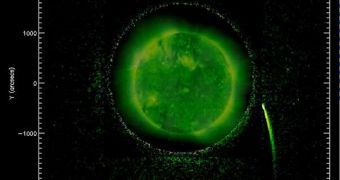Scientists from the University of California in Berkeley (UCB) announce that they were recently able to image the collision between the Sun and a comet in full 3D. They say that this is the first instance they know of in which something like this has been accomplished, and add that the observations are bound to yield further insight into the processes taking place during such cosmic events. The announcement was made yesterday, May 24, Space reports.
“We believe this is the first time a comet has been tracked in 3D space this low down in the solar corona,” explains UCB postdoctoral fellow and solar physicist Claire Raftery. She is a part of the group of four postdoctoral researchers at the university that used that STEREO satellite to conduct the investigations. The Solar Terrestrial Relations Observatory is a mission ran by NASA that employs twin explorers to capture views of the Sun from two different perspectives. This allows for the creation of 3D images, which have incredible depth-of-detail. One of the STEREO spacecrafts flies in front of our planet, as it follows its orbit, while the other trails behind.
Grazing comets, such as the one that was recently researched, are generally very difficult to track, because they are not very bright. They light they reflect is easily lost in the overall radiation of the Sun, and it's very rare that observatories such as STEREO and SOHO (the Solar and Heliospheric Observatory) get a chance to see one in action. The new data reveals the fact that the icy rock actually managed to pass through the Sun's outer atmosphere without disintegrating, but that it eventually succumbed to the 180,000-degree-Fahrenheit (100,000-degree-Celsius) heat of the chromosphere. This layer is made of plasma, and is located between the corona and the surface of the Sun.
The cometary impact was observed by the two solar telescopes in March, but no one really paid any attention to it until UCB postdoctoral investigator Juan Carlos Martinez-Oliveros got a hold of the data. The team, which also includes postdoctoral researchers Samuel Krucker and Pascal Saint-Hillaire, presented the findings yesterday, May 24, in Miami, at the 216th meeting of the American Astronomical Society (AAS 2010). Speaking at the conference, the experts again emphasized the importance of using spacecrafts such as STEREO for space studies, not necessarily for studying the Sun. Having multiple perspectives on an event can allow for more of its traits to be extracted or inferred, the UCB group believes.

 14 DAY TRIAL //
14 DAY TRIAL //